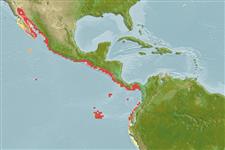Environment: milieu / climate zone / depth range / distribution range
Écologie
marin démersal; profondeur 46 - 90 m (Ref. 9342). Subtropical; 33°N - 10°S, 116°W - 78°W (Ref. 5222)
Eastern Pacific: southern California in the USA, south to Peru.
Taille / Poids / Âge
Maturity: Lm ? range ? - ? cm
Max length : 100.0 cm TL mâle / non sexé; (Ref. 5222)
Épines dorsales (Total): 11; Rayons mous dorsaux (Total): 16-18; Épines anales 3; Rayons mous anaux: 8. Distinguished by the following characteristics: dark red or brown head and body; darker pectoral fins than body; tips of interspinous dorsal fin membranes darker than the rest of the membranes; prominent black moustache streak occurs above maxilla; depth of body contained 2.4-2.6 times in SL; head length 2.3-2.4 times in SL; convex interorbital area; rounded preopercle, finely serrate, enlarged serrae at angle but covered by skin; distinctly convex upper edge of operculum (Ref. 89707).
Common in the Gulf of California. Occasionally encountered in isolated reefs and sandy bottoms near the coast at depths of 46 to 90 m; uncommon in shallow waters (Ref. 89707).
Life cycle and mating behavior
Maturité | Reproduction | Frai | Œufs | Fécondité | Larves
Craig, M.T. and P.A. Hastings, 2007. A molecular phylogeny of the groupers of the subfamily Epinephelinae (Serranidae) with revised classification of the epinephelini. Ichthyol. Res. 54:1-17. (Ref. 83414)
Statut dans la liste rouge de l'IUCN (Ref. 130435)
Menace pour l'homme
Harmless
Utilisations par l'homme
Pêcheries: intérêt commercial mineur
Plus d'informations
Noms communsSynonymesMétabolismePrédateursÉcotoxicologieReproductionMaturitéFraiRassemblement de ponteFéconditéŒufsDéveloppement de l'œuf
RéférencesAquacultureProfil d'aquacultureSouchesGénétiqueElectrophoresesHéritabilitéPathologiesTraitementNutrientsMass conversion
CollaborateursImagesStamps, Coins Misc.SonsCiguateraVitesseType de nageSurface branchialeOtolithesCerveauxVision
Outils
Articles particuliers
Télécharger en XML
Sources Internet
Estimates based on models
Preferred temperature (Ref.
123201): 17 - 26, mean 19.9 °C (based on 16 cells).
Phylogenetic diversity index (Ref.
82804): PD
50 = 0.5001 [Uniqueness, from 0.5 = low to 2.0 = high].
Bayesian length-weight: a=0.01096 (0.00618 - 0.01945), b=3.03 (2.88 - 3.18), in cm total length, based on LWR estimates for this species & Genus-body shape (Ref.
93245).
Niveau trophique (Ref.
69278): 3.9 ±0.7 se; based on size and trophs of closest relatives
Résilience (Ref.
120179): Faible, temps minimum de doublement de population : 4,5 à 14 années (Preliminary K or Fecundity.).
Fishing Vulnerability (Ref.
59153): High vulnerability (60 of 100).
Nutrients (Ref.
124155): Calcium = 39.8 [16.6, 82.2] mg/100g; Iron = 0.73 [0.39, 1.41] mg/100g; Protein = 18.9 [17.0, 20.6] %; Omega3 = 0.353 [0.211, 0.601] g/100g; Selenium = 30.9 [14.9, 65.2] μg/100g; VitaminA = 12.5 [3.6, 49.6] μg/100g; Zinc = 0.516 [0.363, 0.769] mg/100g (wet weight);
